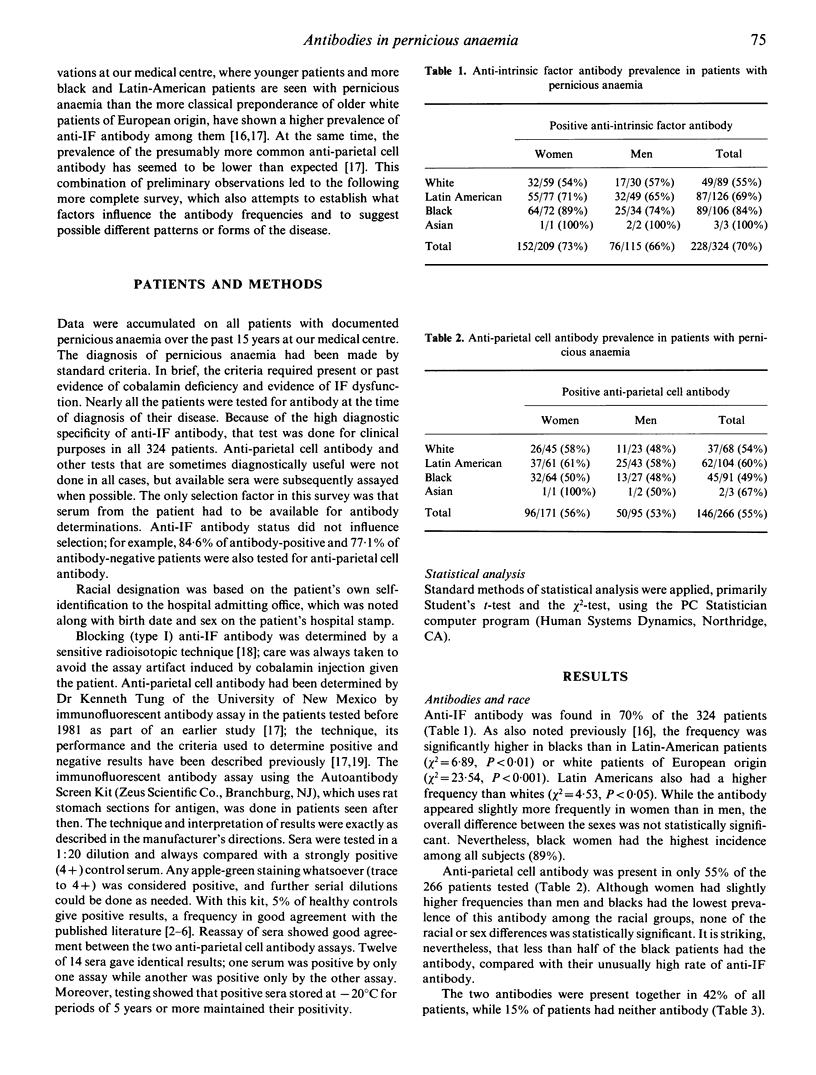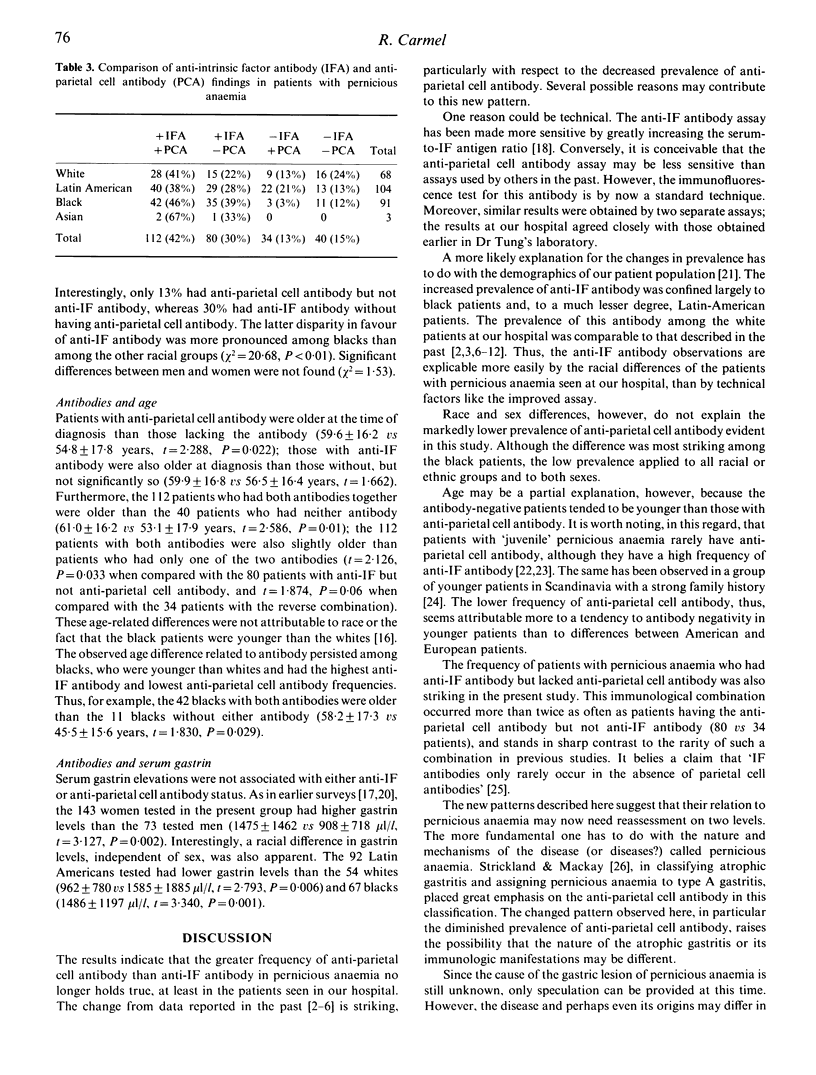Abstract
Anti-parietal cell antibody has been reported in nearly all patients with pernicious anaemia in past studies, in contrast with anti-intrinsic factor (IF) antibody which occurs in only 50-70% of such patients. However, observations in the more diverse patient population at our hospital suggest that these prevalences, originally described in predominantly elderly, white patients of European origin, no longer apply. Anti-IF antibody was found in 70% of the 324 patients, with blacks (84%) and Latin Americans (69%) having a significantly higher prevalence than whites (55%). In contrast, only 55% of the 266 patients tested had anti-parietal cell antibody. It was noteworthy that this low rate was similar in all racial groups. However, patients lacking anti-parietal cell antibody were significantly younger than those who had the antibody (54.8 +/- 17.8 vs 59.6 +/- 16.2 years, P = 0.022). Overall, a striking 30% of all patients had anti-IF antibody but not anti-parietal cell antibody, while only 13% had the latter antibody without having anti-IF antibody. This pattern was particularly striking among black patients. An interesting incidental observation was that gastrin levels were not associated with antibody status, but were significantly higher not only among women than among men but also among white and black patients than among Latin-American patients. The findings show that anti-parietal cell antibody is not found nearly as often in pernicious anaemia as has been reported in the past, and thus has no value as a diagnostic tool in pernicious anaemia. They also suggest clues to different expressions of pernicious anaemia or of its immunologic response, particularly among younger patients with the disease.
Full text
PDF



Selected References
These references are in PubMed. This may not be the complete list of references from this article.
- ADAMS J. F., GLEN A. I., KENNEDY E. H., MACKENZIE I. L., MORROW J. M., ANDERSON J. R., GRAY K. G., MIDDLETON D. G. THE HISTOLOGICAL AND SECRETORY CHANGES IN THE STOMACH IN PATIENTS WITH AUTOIMMUNITY TO GASTRIC PARIETAL CELLS. Lancet. 1964 Feb 22;1(7330):401–403. doi: 10.1016/s0140-6736(64)92785-0. [DOI] [PubMed] [Google Scholar]
- Burman P., Karlsson F. A., Löf L., Axelsson C. K., Szesci P. B., Borch K. H+,K-ATPase antibodies in autoimmune gastritis: observations on the development of pernicious anemia. Scand J Gastroenterol. 1991 Feb;26(2):207–214. doi: 10.3109/00365529109025032. [DOI] [PubMed] [Google Scholar]
- Carmel R., Johnson C. S. Racial patterns in pernicious anemia. Early age at onset and increased frequency of intrinsic-factor antibody in black women. N Engl J Med. 1978 Mar 23;298(12):647–650. doi: 10.1056/NEJM197803232981203. [DOI] [PubMed] [Google Scholar]
- Carmel R., Johnson C. S., Weiner J. M. Pernicious anemia in Latin Americans is not a disease of the elderly. Arch Intern Med. 1987 Nov;147(11):1995–1996. [PubMed] [Google Scholar]
- Carmel R., Ozturk G., Johnson C. S., Tung K. S., Terasaki P. I. Profiles of black and Latin-American patients having pernicious anemia. HLA antigens, lymphocytotoxic antibody, anti-parietal cell antibody serum gastrin levels, and ABO blood groups. Am J Clin Pathol. 1981 Mar;75(3):291–296. doi: 10.1093/ajcp/75.3.291. [DOI] [PubMed] [Google Scholar]
- Carmel R. Pepsinogens and other serum markers in pernicious anemia. Am J Clin Pathol. 1988 Oct;90(4):442–445. doi: 10.1093/ajcp/90.4.442. [DOI] [PubMed] [Google Scholar]
- Davidson R. J., Atrah H. I., Sewell H. F. Longitudinal study of circulating gastric antibodies in pernicious anaemia. J Clin Pathol. 1989 Oct;42(10):1092–1095. doi: 10.1136/jcp.42.10.1092. [DOI] [PMC free article] [PubMed] [Google Scholar]
- Doniach D., Roitt I. M., Taylor K. B. Autoimmunity in pernicious anemia and thyroiditis: a family study. Ann N Y Acad Sci. 1965 Jun 30;124(2):605–625. doi: 10.1111/j.1749-6632.1965.tb18990.x. [DOI] [PubMed] [Google Scholar]
- FISHER J. M., TAYLOR K. B. A COMPARISON OF AUTOIMMUNE PHENOMENA IN PERNICIOUS ANEMIA AND CHRONIC ATROPHIC GASTRITIS. N Engl J Med. 1965 Mar 11;272:499–503. doi: 10.1056/NEJM196503112721002. [DOI] [PubMed] [Google Scholar]
- Fisher J. M. An immunological study of categories of gastritis. Lancet. 1967 Jan 28;1(7483):176–180. doi: 10.1016/s0140-6736(67)91822-3. [DOI] [PubMed] [Google Scholar]
- Hippe E., Jensen K. B. Hereditary factors in pernicious anaemia and their relation to serum-immunoglobulin levels and age at diagnosis. Lancet. 1969 Oct 4;2(7623):721–722. doi: 10.1016/s0140-6736(69)90430-9. [DOI] [PubMed] [Google Scholar]
- Irvine W. J., Davies S. H., Teitelbaum S., Delamore I. W., Williams A. W. The clinical and pathological significance of gastric parietal cell antibody. Ann N Y Acad Sci. 1965 Jun 30;124(2):657–691. doi: 10.1111/j.1749-6632.1965.tb18993.x. [DOI] [PubMed] [Google Scholar]
- Karlsson F. A., Burman P., Löf L., Mårdh S. Major parietal cell antigen in autoimmune gastritis with pernicious anemia is the acid-producing H+,K+-adenosine triphosphatase of the stomach. J Clin Invest. 1988 Feb;81(2):475–479. doi: 10.1172/JCI113344. [DOI] [PMC free article] [PubMed] [Google Scholar]
- Loveridge N., Bitensky L., Chayen J., Hausamen T. U., Fisher J. M., Taylor K. B., Gardner J. D., Bottazzo G. F., Doniach D. Inhibition of parietal cell function by human gammaglobulin containing gastric parietal cell antibodies. Clin Exp Immunol. 1980 Aug;41(2):264–270. [PMC free article] [PubMed] [Google Scholar]
- Nimo R. E., Carmel R. Increased sensitivity of detection of the blocking (type I) anti-intrinsic factor antibody. Am J Clin Pathol. 1987 Dec;88(6):729–733. doi: 10.1093/ajcp/88.6.729. [DOI] [PubMed] [Google Scholar]
- Roitt I. M., Doniach D., Shapland C. Autoimmunity in pernicious anemia and atrophic gastritis. Ann N Y Acad Sci. 1965 Jun 30;124(2):644–656. doi: 10.1111/j.1749-6632.1965.tb18992.x. [DOI] [PubMed] [Google Scholar]
- Samloff I. M., Kleinman M. S., Turner M. D., Sobel M. V., Jeffries G. H. Blocking and binding antibodies to intrinsic factor and parietal call antibody in pernicious anemia. Gastroenterology. 1968 Nov;55(5):575–583. [PubMed] [Google Scholar]
- Strickland R. G., Mackay I. R. A reappraisal of the nature and significance of chronic atrophic gastritis. Am J Dig Dis. 1973 May;18(5):426–440. doi: 10.1007/BF01071995. [DOI] [PubMed] [Google Scholar]
- TAYLOR K. B., ROITT I. M., DONIACH D., COUCHMAN K. G., SHAPLAND C. Autoimmune phenomena in pernicious anaemia: gastric antibodies. Br Med J. 1962 Nov 24;2(5316):1347–1352. doi: 10.1136/bmj.2.5316.1347. [DOI] [PMC free article] [PubMed] [Google Scholar]
- Tanaka N., Glass V. B. Effect of prolonged aministration of parietal cell antibodies from patients with atrophic gastritis and pernicious anemia on the parietal cell mass and hydrochloric acid output in rats. Gastroenterology. 1970 Apr;58(4):482–494. [PubMed] [Google Scholar]
- Tung K. S. A useful technique applicable to the immunofluorescence test. J Immunol Methods. 1977;18(3-4):391–392. doi: 10.1016/0022-1759(77)90194-6. [DOI] [PubMed] [Google Scholar]
- Ungar B., Whittingham S., Francis C. M. Pernicious anaemia: incidence and significance of circulating antibodies to intrinsic factor and to parietal cells. Australas Ann Med. 1967 Aug;16(3):226–229. doi: 10.1111/imj.1967.16.3.226. [DOI] [PubMed] [Google Scholar]
- Wright R., Whitehead R., Wangel A. G., Salem S. N., Schiller K. F. [Autoantibodies and microscopic appearance of gastric mucosa]. Lancet. 1966 Mar 19;1(7438):618–621. doi: 10.1016/s0140-6736(66)90821-x. [DOI] [PubMed] [Google Scholar]


